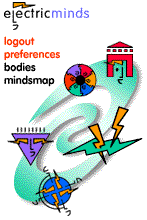
|

|

Come On In, The Data's Fine! What's so great about immersion? If you have ever settled into a book for the evening, leaving your body to occupy that of the protagonist, you know that immersion is powerful. If you have ever played make-believe with a child, delving into the drama of the quest, you know that immersion is fun. If you have ever entered "The Zone" while crafting a piece of prose, poetry or programming, you know that immersion is productive.  When you're immersed in something conceptual, you disregard your physical surroundings- sometimes you even forget the meat wrapped around your bones. Instead, you concentrate fully on the project at hand. It "surrounds" you. That's because you basically make an agreement with yourself to suspend your disbelief in the fictional or non-physical essence of the thing on which you're concentrating. The result is a sense of "presence": you feel as if you're present, in the same space, as the characters in your book, or the constructs in the kid's charade, or the ideas that you're making take shape. That sense of presence, a.k.a. immersion, is the underlying goal of virtual environment (software) developers when they build an interactive simulation that implements virtual reality interfaces. The VR technology (hardware) developers strive to support immersion with the tools they design- whether those tools are wired gloves, VR walls, or headmounted displays. In virtual reality, immersion is the key to the doors of perception. That's because when you're immersed in something, you experience that thing as if it's real. And through experience comes knowledge. If you possess the standard physical capabilities, you experience the world by moving around inside it, manipulating it with your hands, tasting and smelling it, sensing it with your eyes and years. Imagine being able to handle computer data that way! Okay, so maybe you wouldn't want to put it in your mouth. But you certainly would better comprehend a molecule, a melanoma or a shopping mall if you could model it, visualize it and explore it, thereby experiencing its components just as you experience objects in the physical world. That's what immersive technologies let you do: experience data. Interact with data directly, harnessing your natural sensory capabilities. You VIRTUALly enter another REALITY by immersing yourself in an interactive simulation, where you can move freely through virtual space, change your perspective, and handle virtual objects and tools intuitively, naturally, just as you behave in daily life. When you explore and manipulate spatially oriented data using immersive interfaces to 3D graphics, you make decisions and hit goals with greater speed, efficiency and flexibility than ever before. This approach is invaluable in any field where spatial relationships must be visualized, analyzed, engineered, and understood--fields where people engage in such pursuits as bridge-building, space exploration, high-speed police chases, and brain surgery, to name a few. Many folks associate "immersion" with headmounted displays, wired gloves and data suits: "wearable VR." The hot new immersive technologies these days, however, let you experience virtual environments projected on large surfaces, such as tables, walls and floors. We're familiar with looking at and moving objects around on tables and desks, so why not turn a table into an immersive display for virtual objects? One promising piece of gear that takes the "let's-do-it-on-the-table" approach is Fakespace's Immersive Workbench, based on the Responsive Workbench , a research collaboration between the German National Research Council on Information Technology, led by the inquisitive Bernd Froelich, and Stanford University's computer science department, led by the inspirational Patrick Hanrahan.  Another exciting technology that takes the "let's do it against the wall" approach is the ImmersaDesk, from Detroit's Pyramid Systems, based on the aesthetics-driven, techno-R&D work at the University of Illinois-Chicago's Electronic Visualization Laboratory. The ImmersaDesk and Immersive Workbench are new and not cheap; few have been sold. When Pyramid System's Jim Angelillo emails me next week about who's using the ImmersaDesk and for what, I'll update you. As for the Workbench, right now in the United States, NASA/Ames Research Center uses one for such projects as the virtual windtunnel, and in Germany, Daimler Benz uses one for R&D work on new car models. These are people who always seek new way to get immersed in their data. And they're doing it on the table. How have you been immersed lately? |
immersion said: I loved talin's description of electric reality, virtual hallucinations. The mixture of fantasy and technoreality is enlivening and fresh in a way that is so hard to achieve for people like me who thoughts are dominated by hypothetico-deductive scientific empiricism. Your novel world presents an alluring alternative reality. I have a much stodgier approach to VR, trying to decipher how the human mind works from its interactions with the limited representations of reality that goggles offer. It can be exciting at times when a new insight offers itself from the strange perceptions of these semireal environments. I see now how the sense of self in a seeing person is dominated by the reference frame of space, and our understanding is derived from metaphoric extensions of spatial structures and dynamics, that overpower the temporal and melodic sequences of our lesser senses. How I wish I could sing the sense of space! Most Active Topics: Topic 1 Innerductions Topic 3 OSMOSE and the Future of Immersive Experience Topic 22 The Wired Brain? | |||
|
| ||||
Also in Immersion Quest: Virtual Reality Rolls Up Its Sleeves Come On In, The Data's Fine! Being There Here: How and Why | ||||
|
electric minds |
virtual community center |
world wide jam |
edge tech |
tomorrow |
conversations
Any questions? We have answers.
©1996, 1997 electric minds, all rights reserved worldwide.
|


